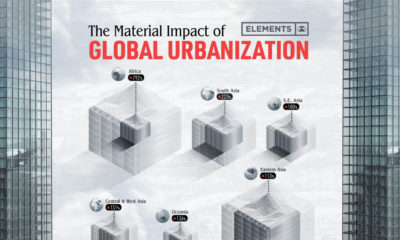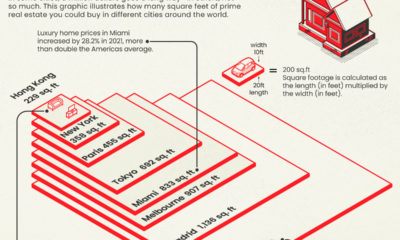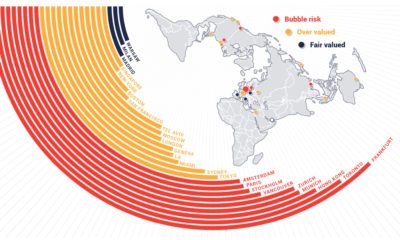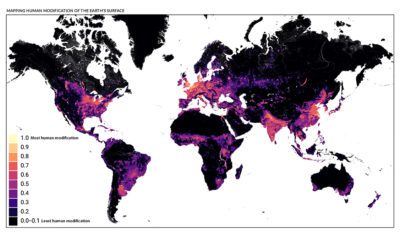This map uses annual rankings from the Economist Intelligence Unit (EIU) to show the world’s most livable cities, measuring different categories including: stability, healthcare, culture and environment, education, and infrastructure.
A Quick Note on Methodology
The ranking attempts to assess which cities across the globe provide the best living conditions, by assigning a score on 30 quantitative and qualitative measures across the five categories with the following weightings: Of the 30 factors within these categories, the qualitative ones are assigned as acceptable, tolerable, uncomfortable, undesirable, or intolerable by a team of expert analysts. Quantitative measures are given a score based on a number of external data points. Everything is then weighted to provide a score between 1-100, with 100 being the ideal.
Ranked: The 10 Most Livable Cities
Of the 172 cities included in the rankings, many of the most livable cities can be found in Europe. However, three of the top 10 are located in Canada: Vancouver, Calgary, and Toronto. Vienna has been ranked number one many times, most recently in 2019. According to the EIU, the Austrian capital only fell out of the top slot during the pandemic years because its famous museums and restaurants were shuttered. Only one Asian city, Osaka, makes the top 10 list, tying with Melbourne for 10th place. Notably, not a single U.S. city is found in the top ranks. Editor’s note: Two cities tie for both the #3 and #10 ranks, meaning that the “top 10” list actually includes 12 cities.
Ranked: The 10 Least Livable Cities
Some of the least livable cities in the world are located across Africa and Central Asia. Many of the least livable cities are within conflict zones, contributing to the low ratings. However, these regions are also home to some of the world’s fastest growing cities, presenting many opportunities for ambitious residents.
The Biggest Changes in Ranking
Let’s take a look at the cities that moved up the global rankings most dramatically compared to last year’s data. Moving Up: The 10 Most Improved Cities Here’s a look at the cities that fell the most in the rankings since last year’s report. Moving Down: The 10 Cities That Tumbled According to the report, a number of cities in New Zealand and Australia temporarily dropped in the ranking due to COVID-19 restrictions. It’s also worth noting that some Eastern European cities moved down in the rankings because of their close proximity to the war in Ukraine. Finally, Kyiv was not included in this year’s report because of the conflict.
Urbanization and Livability
As of 2021, around 57% of the world’s population lives in urban centers and projections show that people worldwide will continue to move into cities. While there are more amenities in urban areas, the pandemic revealed many issues with urbanization and the concentration of large populations. The stress on healthcare systems is felt most intensely in cities and restrictions on public outings are some of the first measures to be introduced in the face of a global health crisis. Now with the cost of living rising, cities may face pressures on their quality of life, and governments may be forced to cut spending on public services. Regardless, people worldwide continue to see the benefits of city living—it’s projected that over two-thirds of the global population will live in cities by 2050. on Even while political regimes across these countries have changed over time, they’ve largely followed a few different types of governance. Today, every country can ultimately be classified into just nine broad forms of government systems. This map by Truman Du uses information from Wikipedia to map the government systems that rule the world today.
Countries By Type of Government
It’s important to note that this map charts government systems according to each country’s legal framework. Many countries have constitutions stating their de jure or legally recognized system of government, but their de facto or realized form of governance may be quite different. Here is a list of the stated government system of UN member states and observers as of January 2023: Let’s take a closer look at some of these systems.
Monarchies
Brought back into the spotlight after the death of Queen Elizabeth II of England in September 2022, this form of government has a single ruler. They carry titles from king and queen to sultan or emperor, and their government systems can be further divided into three modern types: constitutional, semi-constitutional, and absolute. A constitutional monarchy sees the monarch act as head of state within the parameters of a constitution, giving them little to no real power. For example, King Charles III is the head of 15 Commonwealth nations including Canada and Australia. However, each has their own head of government. On the other hand, a semi-constitutional monarchy lets the monarch or ruling royal family retain substantial political powers, as is the case in Jordan and Morocco. However, their monarchs still rule the country according to a democratic constitution and in concert with other institutions. Finally, an absolute monarchy is most like the monarchies of old, where the ruler has full power over governance, with modern examples including Saudi Arabia and Vatican City.
Republics
Unlike monarchies, the people hold the power in a republic government system, directly electing representatives to form government. Again, there are multiple types of modern republic governments: presidential, semi-presidential, and parliamentary. The presidential republic could be considered a direct progression from monarchies. This system has a strong and independent chief executive with extensive powers when it comes to domestic affairs and foreign policy. An example of this is the United States, where the President is both the head of state and the head of government. In a semi-presidential republic, the president is the head of state and has some executive powers that are independent of the legislature. However, the prime minister (or chancellor or equivalent title) is the head of government, responsible to the legislature along with the cabinet. Russia is a classic example of this type of government. The last type of republic system is parliamentary. In this system, the president is a figurehead, while the head of government holds real power and is validated by and accountable to the parliament. This type of system can be seen in Germany, Italy, and India and is akin to constitutional monarchies. It’s also important to point out that some parliamentary republic systems operate slightly differently. For example in South Africa, the president is both the head of state and government, but is elected directly by the legislature. This leaves them (and their ministries) potentially subject to parliamentary confidence.
One-Party State
Many of the systems above involve multiple political parties vying to rule and govern their respective countries. In a one-party state, also called a single-party state or single-party system, only one political party has the right to form government. All other political parties are either outlawed or only allowed limited participation in elections. In this system, a country’s head of state and head of government can be executive or ceremonial but political power is constitutionally linked to a single political movement. China is the most well-known example of this government system, with the General Secretary of the Communist Party of China ruling as the de facto leader since 1989.
Provisional
The final form of government is a provisional government formed as an interim or transitional government. In this system, an emergency governmental body is created to manage political transitions after the collapse of a government, or when a new state is formed. Often these evolve into fully constitutionalized systems, but sometimes they hold power for longer than expected. Some examples of countries that are considered provisional include Libya, Burkina Faso, and Chad.













